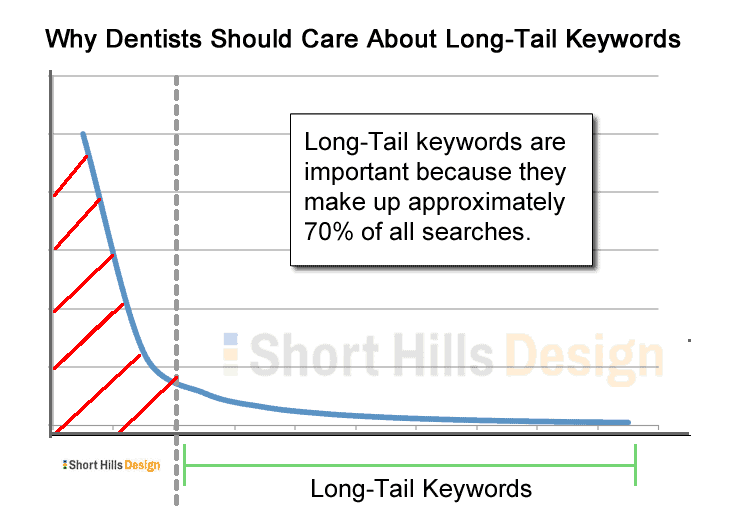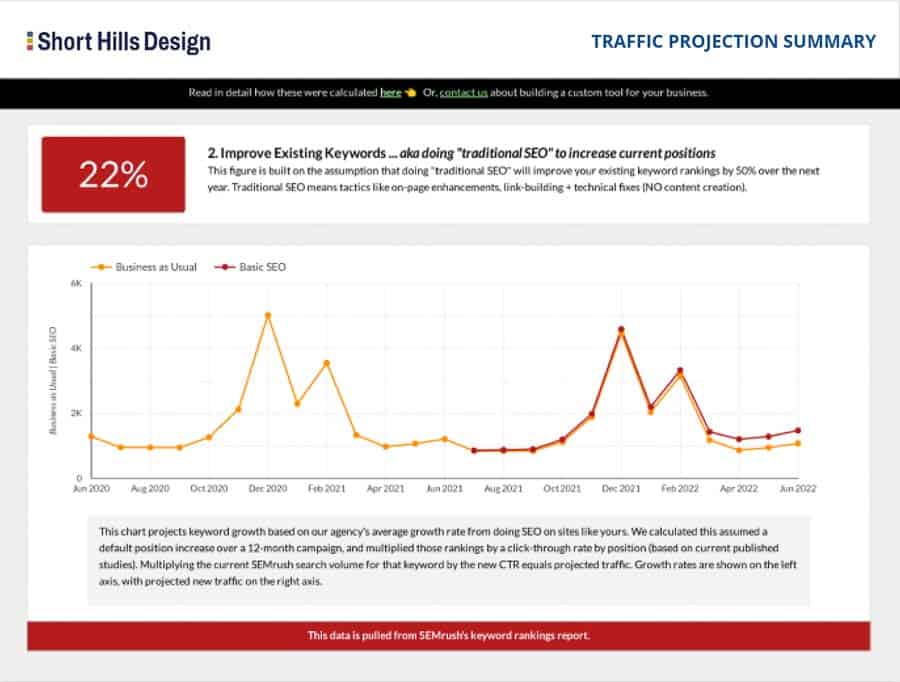In Part I of this series I talked about the big picture of blogging for your dental or medial office's website, and the reasons why blogging is important for success in driving new patients. The first critical benefit I mentioned was the ability to take advantage of long-tail keywords within your blog posts, and in this article I'm going to explain this concept in more detail.
When we talk about keywords there are generally two types: the keywords that we would normally expect people to use, and the keywords that we can't predict that people will use, but are still important.
The term "long-tail" comes from distribution curves in statistics where in the distribution of certain types of graphs looks like a "long-tail" (vs. the "head" of the graph).

1. Keywords. In the graph above, the left side of the graph (with the red hash marks) represents the approximately 30% of search queries that use what we'd call "regular keywords". By "regular" I mean common keywords such as "dentist new york", "veneer dentist new york", "invisalign dentist ny" (of course these are not good keywords to use for a real SEO campaign).
The concept here is that 30% of the searches are for these high-volume keywords. And because they are high-volume, there is likely heavy competition to contend with if you want to rank your pages for these keywords.
2. Long-Tail Keywords. Contrast the above situation to the right side of the graph which shows that 70% of all search terms are what we call "long tail" -- keywords with low search volumes (not a lot of people are searching with these keywords), but as a whole make up the bulk of searches.
The take home here is that even though there's not a lot of volume for each of these keywords individually, as a whole, you have a better chance ranking for one of these long-tail keywords vs. a "regular" keyword as shown above.
Examples of a long tail keywords would be. "what are the black lines around my crowns", "it is normal for kids to grind at night", "why do my gums bleed when I brush". These are keywords that we would (generally) never pursue in an SEO campaign, yet can be very useful for driving traffic to your website (and hopefully new patients) because they are highly focused search terms, but have very low competition (one of the reasons we wouldn't pursue these keywords in a "real" SEO campaign is because the search volume is too low for each individual keyword).
The whole point of using long-tail keywords is for you the dentist to write blog posts where you "guesstimate" the keywords based on your experience with what people would search for or simply what people ask about chairside in your practice .
Remember we are NOT doing keyword research for these long-tail keywords -- these keywords are the proverbial "icing on the cake". It's critical to understand that we would not take such a casual approach if we were trying to rank a page for an important (well-researched and documented) keyword such as "invislign dentist" -- as this is not a long-tail keyword.
And because we really don't know what the long-tail keywords are in advance (there are a thousand different ways people can ask about "black lines" around their crown margins), the idea is to write blog posts that generally cover the subject using terms that you think would match people's search queries. And now that you have a blog post about "black lines around crowns", we hope that when someone does a search with long-tail keywords such as:
...that your blog post about the subject will hopefully appear in search results for some or all of these queries.
Of course the caveat is as it is with all SEO efforts -- your level of competition is critical. If you are the only dentist in your area with a blog post (and thereby a page) about "black lines around crowns", then it's very likely that your page will come up for the above searches. However, if all 10 of your competitors have blog posts about "black lines", then the particular details of your post ("caps" vs. "crowns", header tags, etc.) will make more of a difference when it comes to ranking the pages.
As it stands right now, many of your colleagues do NOT take advantage of long-tail keywords, and are not blogging. Thus, if you write blog articles -- 2-3 paragraphs each -- once per month or two -- you should have a significant advantage over your colleagues who have yet to jump on the "blogging train". And that advantage should hopefully turn into more new patients, and a more successful practice. Next week in Part III of this series on blogging for your dental and medical practice, I am going to explain why "freshness" of your website (the content -- not the smell 😉 ) matters.

